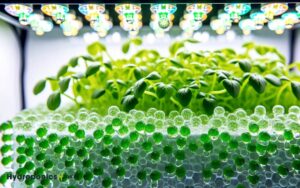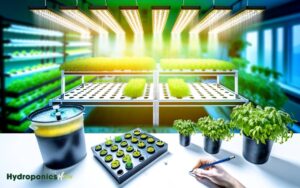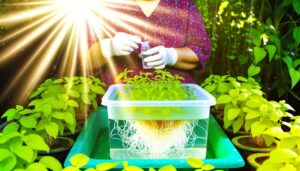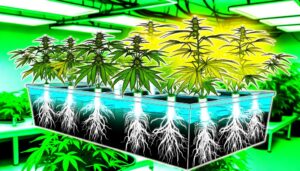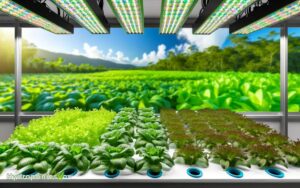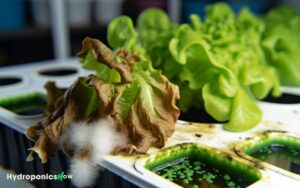Do Hydroponically Grown Plants Have Unique Roots?
Yes, hydroponically grown plants do have roots. These roots are actually more extensive and fibrous compared to soil-grown counterparts due to constant access to nutrient-rich solutions.
In systems like NFT and DWC, roots thrive in a controlled environment, optimizing nutrient uptake and oxygenation. They grow white and healthy, indicating efficient water and nutrient absorption.
However, maintaining vital conditions like pH levels and oxygenation is essential to prevent issues like root rot.
By understanding the specifics of root growth in hydroponics, you can guarantee superior plant development and yields. Explore further to grasp all the intricate details of hydroponic root systems.

Key Takeaways
Basics of Hydroponics
Hydroponics, a method of growing plants without soil, relies on nutrient-rich water to deliver essential minerals directly to the roots. In this system, you’ll find that plants are cultivated in a controlled environment, ensuring ideal growth conditions.
You can use various hydroponic setups, such as nutrient film technique (NFT), deep water culture (DWC), and aeroponics, to cater to different plant needs.
Each system precisely regulates pH levels, oxygenation, and nutrient concentrations, which maximizes plant absorption rates.
Studies have shown that hydroponically grown plants often exhibit faster growth rates and higher yields compared to soil-grown counterparts.
This soil-free method also minimizes pest and disease risks, leading to healthier plants and more efficient use of water and nutrients.
Root Development in Hydroponics
In a hydroponic system, root development is vital for plant health, as roots must efficiently absorb water, nutrients, and oxygen from the nutrient solution.
You’ll notice that roots in hydroponics typically grow longer and more fibrous compared to soil-grown plants. This is due to the direct availability of nutrients and the absence of physical soil barriers.
The constant exposure to oxygen-rich water promotes robust root growth and prevents issues like root rot. Roots must adapt to their aqueous environment, which can be observed in their increased surface area for best nutrient uptake.
Research shows that hydroponically grown roots often exhibit enhanced absorption capabilities, contributing to faster plant growth and higher yields.
It’s important to monitor nutrient solution quality to promote healthy root development.
Types of Hydroponic Systems
In Deep Water Culture (DWC), plants’ roots are submerged in oxygenated nutrient solutions, promoting rapid growth.
Nutrient Film Technique (NFT) utilizes a thin film of nutrient-rich water flowing over roots, ensuring efficient nutrient uptake.
Aeroponics suspends roots in the air, misting them with nutrients, maximizing oxygen exposure.
Ebb and Flow systems periodically flood and drain nutrient solutions, balancing moisture and aeration.
Wick systems use capillary action to draw nutrients to roots, suitable for smaller plants.
Nutrient Solutions Explained
Understanding nutrient solutions is crucial, as they provide the essential elements required for ideal plant growth in hydroponic systems.
These solutions contain a balanced mix of macronutrients like nitrogen, phosphorus, potassium, and micronutrients such as iron, manganese, and zinc.
You must maintain ideal pH levels, ideally between 5.5 and 6.5, to guarantee nutrient uptake efficiency.
Regularly monitor electrical conductivity (EC) to gauge nutrient concentration, aiming for levels between 1.2 to 2.0 mS/cm, depending on the plant species. Use chelated forms of trace elements to enhance solubility and availability.
Avoid nutrient imbalances by frequently testing and adjusting the solution. By mastering these aspects, you’ll promote robust plant growth and maximize yields in your hydroponic system.
Root Structure and Function
To thrive in a hydroponic system, plant roots must effectively absorb water, nutrients, and oxygen while providing structural stability. Root structures in hydroponics differ slightly from soil-grown plants.
You’ll notice hydroponic roots often appear white and more fibrous, indicating healthy growth. The root apex, root hairs, and lateral roots play crucial roles in nutrient uptake and anchorage.
Here’s a breakdown:
| Root Part | Function |
|---|---|
| Root Apex | Drives root growth and direction. |
| Root Hairs | Increase surface area for absorption. |
| Lateral Roots | Enhance stability and nutrient uptake. |
| Epidermis | Protects and regulates exchange. |
| Cortex | Stores nutrients and water. |
Understanding these components guarantees you can optimize your hydroponic system for robust plant growth.
Oxygen and Root Health
Sufficient oxygenation of the root zone is vital for preventing root hypoxia and ensuring optimal nutrient uptake in hydroponic systems. You must provide dissolved oxygen levels above 5 ppm to maintain root respiration.
Inadequate oxygen leads to hypoxic conditions, affecting root metabolic functions and nutrient absorption. Studies show that roots in adequately oxygenated environments exhibit improved growth rates and resilience against pathogens.
Utilize air stones, diffusers, or oxygenating pumps to optimize oxygenation. Regularly monitor dissolved oxygen levels using a DO meter.
Comparing Soil and Hydroponic Roots
When comparing soil and hydroponic roots, you’ll notice distinct differences in root structure, nutrient delivery methods, and root health indicators.
Hydroponic systems facilitate more efficient nutrient uptake, resulting in generally finer and more fibrous root structures.
Additionally, root health can be monitored more closely in hydroponics, allowing for immediate adjustments to nutrient and oxygen levels.
Root Structure Differences
In comparing the root structures of soil-grown and hydroponically grown plants, you’ll notice significant differences in root morphology and function.
Soil-grown plants typically develop extensive, fibrous root systems designed for anchorage and nutrient foraging. These roots exhibit a complex architecture with various root hairs to maximize surface area.
Conversely, hydroponically grown plants display a more streamlined root structure, often characterized by fewer lateral roots and root hairs.
This difference arises because hydroponic systems deliver nutrients directly to the roots, eliminating the need for extensive root exploration.
Studies have shown hydroponic roots are often thicker and less branched, focusing more on nutrient uptake efficiency. This streamlined morphology reflects their adaptation to a nutrient-rich, water-based environment.
Nutrient Delivery Methods
Both soil and hydroponic systems employ distinct nutrient delivery methods that greatly influence root morphology and function.
In soil, plants rely on capillary action to absorb nutrients dissolved in water from the surrounding medium. Conversely, hydroponic systems deliver nutrients directly to the roots via nutrient-rich solutions, ensuring consistent availability.
This difference affects root architecture: soil-grown roots often extend extensively to seek nutrients, while hydroponic roots tend to be more compact and fibrous due to the constant nutrient supply.
| Nutrient Delivery | Soil-Based Systems | Hydroponic Systems |
|---|---|---|
| Method | Capillary action | Direct solution |
| Root Structure | Extensive, branched | Compact, fibrous |
| Nutrient Access | Variable | Consistent |
Understanding these differences helps you optimize plant growth across different systems.
Root Health Indicators
Recognizing root health indicators in both soil and hydroponic systems requires a detailed understanding of morphological and physiological signs. This allows you to effectively assess and optimize plant vitality.
In soil systems, healthy roots appear firm, white, and fibrous, signifying efficient nutrient uptake and robust growth. Conversely, hydroponic roots should be similarly white but are often more translucent and less fibrous due to constant nutrient solution exposure.
Indicators of poor root health include discoloration, such as browning or blackening, and a slimy texture, often caused by pathogens or inadequate oxygenation.
Regular monitoring and maintaining ideal environmental conditions oxygen levels, pH, and nutrient concentrations are essential.
Benefits of Hydroponic Roots
In addition, hydroponic roots exhibit enhanced nutrient uptake due to their direct exposure to nutrient-rich solutions, which maximizes growth efficiency.
Additionally, the compact root systems in hydroponics make space utilization more efficient, allowing you to cultivate more plants in a given area.
Studies have shown that these advantages lead to increased yields and faster growth rates compared to traditional soil-based methods.
Enhanced Nutrient Uptake
Hydroponic systems enhance nutrient uptake by providing roots with direct and consistent access to a nutrient-rich solution, maximizing growth efficiency and plant health.
This method guarantees that essential macro and micronutrients are readily available, avoiding soil-related nutrient deficiencies and imbalances. You’ll find that this results in faster growth rates and higher yields compared to traditional soil-based cultivation.
Studies show that hydroponically grown plants exhibit increased nutrient absorption efficiency, leading to peak chlorophyll production and robust development. Additionally, the controlled environment minimizes the risk of root diseases and pests.
By maintaining ideal pH levels and nutrient concentrations, hydroponic systems facilitate superior nutrient uptake, ensuring your plants receive precisely what they need for optimum physiological functioning.
Space Efficiency
Often, hydroponic systems maximize space efficiency by allowing plants to grow vertically and their roots to expand in nutrient solutions without the constraints of soil.
This vertical growth model optimizes limited space, making it ideal for urban farming and indoor gardening. By eliminating soil, you can closely control root growth, resulting in denser planting arrangements.
Research indicates that hydroponic setups can yield up to 90% more produce per square foot compared to traditional soil-based agriculture.
Additionally, hydroponic roots are generally more compact and efficient in nutrient absorption, reducing the need for extensive root systems.
This efficiency translates to smaller footprint operations, enabling you to cultivate a greater number of plants in confined areas, thereby maximizing productivity.
Common Root Issues
One of the most prevalent root issues in hydroponic systems is root rot, often caused by the waterborne pathogen Pythium. This pathogen thrives in poorly oxygenated, stagnant water, leading to brown, mushy roots.
You’ll notice stunted growth and yellowing leaves as the plant struggles to uptake nutrients. High humidity and warm temperatures exacerbate the problem, creating an ideal environment for Pythium proliferation.
Maintaining proper oxygen levels and water temperatures below 75°F can mitigate this risk. Regularly inspect roots for discoloration or sliminess, and make sure your nutrient solution is well-aerated.
Employing beneficial microbes like Trichoderma can also combat Pythium. By staying vigilant and proactive, you can safeguard your plants from root rot and promote healthier growth.
Enhancing Root Growth
To enhance root growth in hydroponically grown plants, you should focus on optimizing nutrient solution composition, employing effective oxygenation and aeration techniques, and maintaining ideal root zone temperatures.
Evidence suggests that precise nutrient balance and adequate dissolved oxygen levels notably improve root development and overall plant health.
Additionally, regulating root zone temperature can prevent stress and promote robust growth.
Nutrient Solution Optimization
Optimizing the nutrient solution is essential for enhancing root growth in hydroponically grown plants, as it directly influences nutrient uptake efficiency and overall plant health.
You need to balance key macronutrients like nitrogen, phosphorus, and potassium, as well as essential micronutrients such as iron, manganese, and zinc. Evidence shows that precise nutrient ratios promote robust root systems.
Regularly monitor pH levels, ideally between 5.5 and 6.5, to guarantee peak nutrient availability. Use electrical conductivity (EC) measurements to gauge nutrient concentration, adjusting as necessary based on plant growth stage.
Studies indicate that maintaining an EC level between 1.2 and 2.0 mS/cm fosters better root development.
Oxygenation and Aeration Techniques
How does enhancing oxygenation and aeration in hydroponic systems contribute to improved root growth and overall plant health?
Oxygenation and aeration are essential because roots need oxygen for cellular respiration, which fuels energy production. Without sufficient oxygen, roots may suffer from hypoxia, leading to diminished nutrient uptake and stunted growth.
Implementing techniques like air stones, diffusers, or Venturi injectors can increase dissolved oxygen levels in nutrient solutions. Studies show that higher oxygen levels result in stronger, more extensive root systems.
Enhanced aeration also prevents root rot by inhibiting anaerobic bacteria and fungi. By improving oxygenation, you’ll promote healthier root development, ensuring your plants have the strong foundation they need for optimal growth and productivity.
Root Zone Temperature
Maintaining an ideal root zone temperature is crucial for maximizing nutrient uptake and overall plant health in hydroponic systems.
You should aim to keep the root zone within the best range of 65-75°F (18-24°C). At these temperatures, enzymatic activities facilitating nutrient absorption are at their peak efficiency.
If the temperature deviates too far, root stress can occur, leading to reduced growth and increased susceptibility to pathogens.
Research indicates that temperatures above 80°F (27°C) can cause root rot, while temperatures below 60°F (15°C) can slow metabolic processes.
Utilize water heaters or chillers to maintain stability. Monitoring tools, such as digital thermometers, help ensure accuracy.
Future of Hydroponic Root Systems
Researchers are increasingly focusing on innovative materials and advanced technologies to enhance the efficiency and resilience of hydroponic root systems.
- You’re likely to see bioengineered substrates that optimize aeration and nutrient absorption.
- Advanced sensors can monitor root health in real-time, providing data to adjust environmental conditions instantly.
- Nanotechnology is also making strides, with nanoparticles potentially delivering nutrients more effectively.
- Vertical farming setups are evolving, integrating root zone cooling systems to maintain ideal temperatures.
- Evidence shows that these developments can lead to faster growth rates and higher yields.
Conclusion
You’d think roots would be unnecessary in hydroponics, right? But ironically, they’re essential.
Hydroponically grown plants develop intricate root systems to absorb nutrient solutions directly. These roots are marvels of efficiency, optimized for water and nutrient uptake. Despite the absence of soil, hydroponic roots thrive, often surpassing their soil-grown counterparts. This resilience is partly due to the silica effect on plant roots, which strengthens cell walls and enhances resistance to stress. Stronger roots improve nutrient absorption, leading to healthier and more vigorous plant growth. As a result, hydroponically grown plants often exhibit accelerated development and higher yields compared to traditional soil cultivation.
So, while soil may seem indispensable for roots, hydroponics proves that plants can flourish—and even excel—without it. The future of root systems is indeed rooted in innovation.

